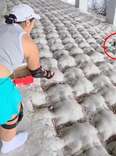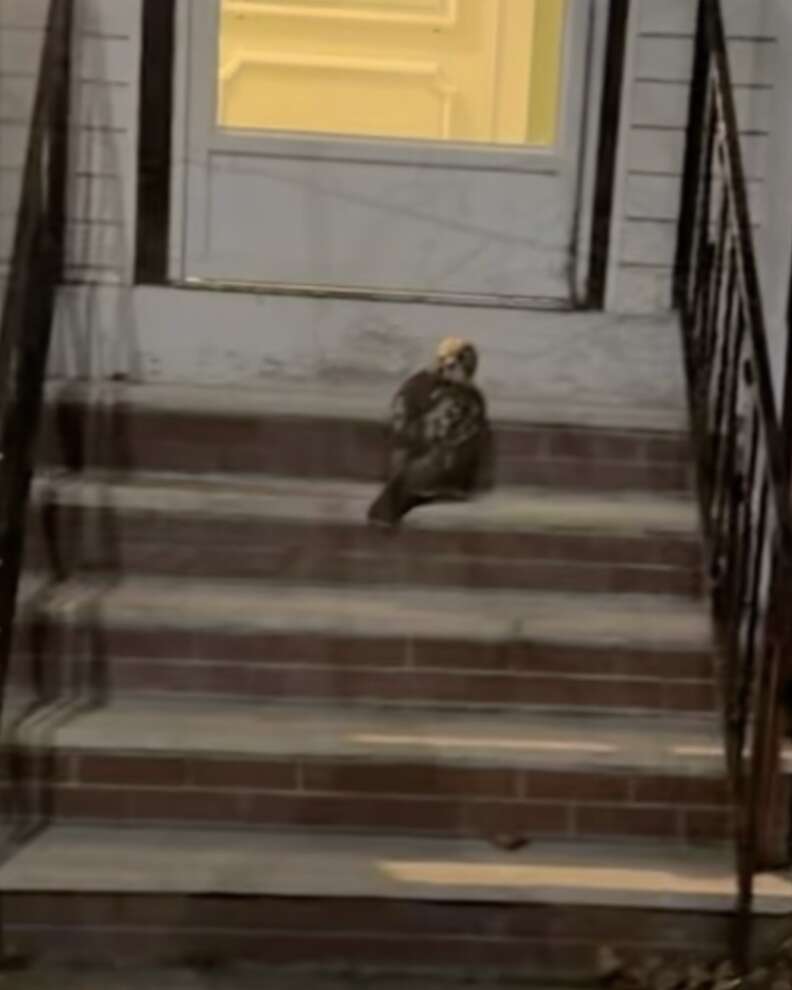“[They’re] prowling in the shadows …” 😨
By Ashley Ortiz
Published on Sep 19, 2025 at 7:10 PM
As soon as night falls, photographer Tan Yong Lin likes to venture around his hometown in Singapore, hoping to capture someone elusive on film. He loves to photograph the wildlife in and around his city, but one of his favorite muses can hardly be seen during the day.
With the camera strapped around his neck, Lin walks around gazing at the trees, hoping to find a distinct pair of giant, round eyes staring at him.
Finally, he sees him: a common palm civet scurrying between houses, cloaked in darkness.

Lin points the camera at the civet, but he has a different approach when photographing them than he does with other wildlife.
“The civets are largely nocturnal, and I do not use any artificial lights to photograph them, relying on the ambient light of the housing estates for my photos,” Lin told The Dodo.

Illuminated solely by the dim house lights surrounding him, the palm civet looks at Lin and seemingly poses for a shot before dashing away.

Since they’re nocturnal, most Singaporean residents miss the opportunity to see these little creatures, like Facebook user Hei Mao Mao, who commented on Lin’s photos in surprise.
“[I] live in [Singapore] for 50 [years and] never seen one,” Mao Mao commented.

Palm civet sightings may be uncommon for some, but Lin is constantly on the lookout for them. He’s encountered countless wildlife sightings throughout his career, but seeing a palm civet running around always feels special.
“Prowling in the shadows, our urban common palm civets use the cover of nightfall to hunt and search for food, both on the trees and on the ground,” Lin wrote on Facebook. “Making use of urban features, such as fences and railings, they navigate our sleeping city with ease. With the abundance of tall trees in our neighborhoods, they are also able to easily seek refuge in them should they feel threatened at any time.”

There’s no question that palm civets feel safest when they can roam around the city at night without being seen. And thankfully, even when they come across adoring spectators like Lin, the civets in Singapore receive the respect and space they require to thrive.
“These civets can be extremely shy as well, so I will keep my movement minimal and give them space by keeping a distance,” Lin said.
You can see more of Tan Yong Lin’s photography by following him on Facebook and Instagram.

Related
Rollerbladers Stop On A Dime To Help A Ball Of Feathers Dumped Under A Bridge
“We were meant to find him” ❤️
Want more animals?
Get a daily dose of uplifting animal stories straight to your inbox
Subscribe
By signing up, I agree to the Terms and Privacy Policy.
Dodo Shows
00:00
03:38
https://imasdk.googleapis.com/js/core/bridge3.723.0_en.html#deid=%22%22&eventfe_experiment_ids=%5B%5D&fid=%22goog_1779250189%22&genotype_experiment_data=%7B%22experimentStateProto%22%3A%22%5B%5B%5B45713128%2Cnull%2Cnull%2C%5B%5D%5D%2C%5B803064088%2Cnull%2Cnull%2C%5B1%5D%5D%2C%5B45681221%2Cnull%2Cnull%2C%5B1%5D%5D%2C%5B45722344%2Cnull%2Cnull%2C%5B%5D%5D%2C%5B45706017%2Cnull%2Cnull%2C%5B%5D%5D%2C%5B45668885%2Cnull%2Cnull%2C%5B%5D%5D%2C%5B45685340%2Cnull%2Cnull%2C%5B%5D%5D%2C%5B45663239%2Cnull%2Cnull%2C%5B%5D%5D%2C%5B45715032%2Cnull%2Cnull%2C%5B1%5D%5D%2C%5B45661356%2Cnull%2Cnull%2C%5B%5D%5D%2C%5B45676441%2Cnull%2Cnull%2C%5B%5D%5D%2C%5B45675307%2Cnull%2Cnull%2C%5B1%5D%5D%2C%5B45675308%2Cnull%2Cnull%2C%5B1%5D%5D%2C%5Bnull%2C45645574%2Cnull%2C%5B%5D%5D%2C%5B45702384%2Cnull%2Cnull%2C%5B%5D%5D%2C%5B45726365%2Cnull%2Cnull%2C%5B1%5D%5D%2C%5B45692337%2Cnull%2Cnull%2C%5B1%5D%5D%2C%5B45688859%2Cnull%2Cnull%2C%5B%5D%5D%2C%5B45656766%2Cnull%2Cnull%2C%5B%5D%5D%2C%5B45710689%2Cnull%2Cnull%2C%5B%5D%5D%2C%5B45710688%2Cnull%2Cnull%2C%5B%5D%5D%2C%5B45685601%2Cnull%2Cnull%2C%5B%5D%5D%2C%5Bnull%2C45685602%2Cnull%2C%5Bnull%2C500%5D%5D%2C%5B775241416%2Cnull%2Cnull%2C%5B%5D%5D%2C%5B781107959%2Cnull%2Cnull%2C%5B%5D%5D%2C%5B781107958%2Cnull%2Cnull%2C%5B%5D%5D%2C%5B792614055%2Cnull%2Cnull%2C%5B%5D%5D%2C%5B781107957%2Cnull%2Cnull%2C%5B%5D%5D%2C%5B45658982%2Cnull%2Cnull%2C%5B%5D%5D%2C%5B45725657%2Cnull%2Cnull%2C%5B%5D%5D%5D%2C%5B%5B16%2C%5B%5B1%2C%5B%5B31089630%5D%2C%5B31089631%2C%5B%5B45668885%2Cnull%2Cnull%2C%5B1%5D%5D%5D%5D%5D%5D%2C%5B50%2C%5B%5B31092099%5D%2C%5B31092100%2C%5B%5Bnull%2C749060184%2Cnull%2C%5Bnull%2C100%5D%5D%5D%5D%5D%5D%2C%5B1%2C%5B%5B31094192%5D%2C%5B31094193%2C%5B%5B775241416%2Cnull%2Cnull%2C%5B1%5D%5D%5D%5D%5D%5D%2C%5B1000%2C%5B%5B95332046%5D%5D%5D%2C%5Bnull%2C%5B%5B95332047%5D%5D%5D%2C%5B10%2C%5B%5B95333808%5D%2C%5B95333809%2C%5B%5B635466687%2Cnull%2Cnull%2C%5B1%5D%5D%5D%5D%5D%5D%2C%5B10%2C%5B%5B95338769%2C%5B%5Bnull%2C45645574%2Cnull%2C%5Bnull%2C1%5D%5D%5D%5D%2C%5B95338770%2C%5B%5Bnull%2C45645574%2Cnull%2C%5Bnull%2C2%5D%5D%5D%5D%5D%5D%2C%5B10%2C%5B%5B95345206%5D%2C%5B95345207%2C%5B%5B45661356%2Cnull%2Cnull%2C%5B1%5D%5D%5D%5D%5D%5D%2C%5B10%2C%5B%5B95356068%5D%2C%5B95356069%2C%5B%5B45685601%2Cnull%2Cnull%2C%5B%5D%5D%2C%5Bnull%2C45685602%2Cnull%2C%5B%5D%5D%5D%5D%2C%5B95356070%2C%5B%5B45685601%2Cnull%2Cnull%2C%5B1%5D%5D%2C%5Bnull%2C45685602%2Cnull%2C%5B%5D%5D%5D%5D%2C%5B95356071%2C%5B%5B45685601%2Cnull%2Cnull%2C%5B1%5D%5D%2C%5Bnull%2C45685602%2Cnull%2C%5Bnull%2C100%5D%5D%5D%5D%5D%5D%2C%5B100%2C%5B%5B95364127%5D%2C%5B95364128%2C%5B%5B45706017%2Cnull%2Cnull%2C%5B1%5D%5D%5D%5D%5D%5D%2C%5B100%2C%5B%5B95365753%2C%5B%5B45710689%2Cnull%2Cnull%2C%5B1%5D%5D%5D%5D%2C%5B95365754%2C%5B%5B45710688%2Cnull%2Cnull%2C%5B1%5D%5D%5D%5D%5D%5D%2C%5Bnull%2C%5B%5B95366606%5D%2C%5B95366607%2C%5B%5B45713128%2Cnull%2Cnull%2C%5B1%5D%5D%5D%5D%5D%5D%2C%5Bnull%2C%5B%5B95370402%5D%2C%5B95370403%2C%5B%5B45722344%2Cnull%2Cnull%2C%5B1%5D%5D%5D%5D%5D%5D%2C%5B5%2C%5B%5B95371971%5D%2C%5B95371972%2C%5B%5B45725657%2Cnull%2Cnull%2C%5B1%5D%5D%5D%5D%5D%5D%2C%5B10%2C%5B%5B95372277%5D%2C%5B95372278%2C%5B%5Bnull%2C745150931%2Cnull%2C%5Bnull%2C1%5D%5D%5D%5D%5D%5D%2C%5B1%2C%5B%5B95373378%2C%5B%5B792614055%2Cnull%2Cnull%2C%5B1%5D%5D%5D%5D%2C%5B95373379%2C%5B%5B781107959%2Cnull%2Cnull%2C%5B1%5D%5D%2C%5B792614055%2Cnull%2Cnull%2C%5B1%5D%5D%2C%5B781107957%2Cnull%2Cnull%2C%5B1%5D%5D%5D%5D%5D%5D%5D%5D%5D%2Cnull%2Cnull%2C%5Bnull%2C1000%2C1%2C1000%5D%5D%22%7D&imalib_experiments=%5B95322027%2C95331589%2C31092099%2C95332046%5D&managed_js_experiment_id=0&pvsid=7067893907548338Guy And His Dog Are Visiting All 50 States On A Motorcycle
Read Full Article
Sick Hawk Waits On Stoop, Hoping Someone Will Help Him
“This hawk wasn’t able to fly away, which set off alarm bells.”
On a recent evening, a man was out walking his dog when he spotted someone huddled on his neighbor’s stoop. Upon closer inspection, he realized the animal was a red-tailed hawk — and he needed help.

“[H]e noticed this hawk wasn’t able to fly away, which set off alarm bells,” Priya Patel, wildlife medical director at New England Wildlife Centers (NEWC), told The Dodo. “Normally they don’t like to be around people and they try to fly away.”
The man wrapped the bird in his jacket and made sure he was safely transported to NEWC. When the bird arrived at the center, Patel wasn’t quite sure what was wrong with him. But when she noticed one of his wings was swollen with no sign of injury, she began to suspect he’d ingested rodenticide.

When an animal higher on the food chain, like a red-tailed hawk, eats prey with second-generation anticoagulant rodenticides (SGARs) in their system, the predator animal gets poisoned as well. The poison leads to many serious health concerns, including their blood losing its clotting ability.
After testing his blood, Patel confirmed that the hawk had, in fact, consumed rodent poison. She started treating him right away, giving him vitamin K to help his blood clot as well as pain medication and fluids.
Unfortunately, in her work as a wildlife veterinarian, Patel has treated many animals poisoned by rodenticides. And because pest control poisons have been getting stronger over the years, it’s taking longer and longer to treat poisoned animals.
“We’ve treated cases for almost a year sometimes,” Patel said.

In order to avoid more animals like this hawk getting poisoned by rodenticides, it’s important to be thoughtful about rodent management.
“Have someone come and assess areas where rodents can enter your house … and plug those up,” Patel said. “[Secure] any type of trash, food products, things like that.”
If you still need to relocate any rodents, consider using humane traps instead of rodenticides or glue traps. Your local wildlife will thank you.
https://www.instagram.com/p/C3QXXrbqmCg/embed/?cr=1&v=14&wp=810&rd=https%3A%2F%2Fwww.thedodo.com&rp=%2Fdaily-dodo%2Fsick-hawk-waits-on-stoop-hoping-someone-will-notice-him#%7B%22ci%22%3A0%2C%22os%22%3A22216.699999928474%2C%22ls%22%3A21586.5%2C%22le%22%3A22181.5%7D
Luckily for this hawk, even though he hasn’t been in treatment for very long, he’s already doing much better. Over the next few months, Patel will continue treating the hawk and testing his progress. She’s confident he’ll make a full recovery.
Once the hawk is feeling completely better, NEWC will release him back into his natural environment, where he’ll get a second chance at life.
To help support other animals like this hawk, you can make a donation to NEWC here.

Related
Scientists Document Rare Wolves Enjoying A … Sweet Treat?
Researchers call it the “dessert hypothesis” 😂
Want more animals?
Get a daily dose of uplifting animal stories straight to your inbox
Subscribe
By signing up, I agree to the Terms and Privacy Policy.